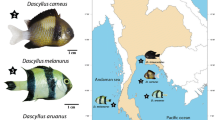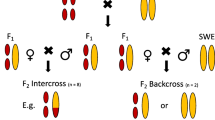Abstract
Work on the genetics of cladocerans reproducing by cyclic parthenogenesis has indicated that populations usually include a large number of genotypes, whose frequencies are in close approximation to Hardy-Weinberg equilibrium. Less diverse genotypic arrays and pronounced instability in genotype frequencies occur only in permanent populations exposed to limited ephippial recruitment. Genetic diversification among local cladoceran populations is greater than in most other organisms as a consequence of the inefficiency of passive dispersal. Genotypic characteristics of cladocerans reproducing by obligate parthenogenesis are markedly different from those of cyclic parthenogens. Local populations include few clones, but genetic distances between them are often large and accompanied by significant ecological and morphological divergence. When considered over their entire range, cladoceran taxa reproducing by obligate asexuality are the most genotypically diverse asexual organisms known. This diversity has originated from the spread of a sex-limited meiosis suppressor through species that originally reproduced by cyclic parthenogenesis. The confused state of cladoceran taxonomy is partially a consequence of the presence of such obligately asexual groups, but also results from the occurrence of hybridization and sibling species. The genome size of cladocerans is exceptionally small and is associated with a large amount of endopolyploidy. Somatic tissues in adult cladocerans show a range in nuclear DNA content from 2–2048 c. DNA quantification studies have additionally revealed the frequent occurrence of polyploid clones in obligately asexual taxa.
Similar content being viewed by others
References
Allendorf, F. W., K. L. Knudsen & G. M. Blake, 1982. Frequencies of null alleles at enzyme loci in natural populations of Ponderosa and red pine. Genetics 100: 497–504.
Bachmann, K. & E. L. Rheinsmith, 1973. Nuclear DNA amounts in Pacific Crustacea. Chromosoma 37: 405–416.
Bennett, M. D., 1971. The duration of meiosis. Proc. R. Soc. B. 178: 277–299.
Bennett, M. C., 1972. Nuclear DNA content and minimum generation time in herbaceous plants. Proc. R. Soc. B. 181: 109–135.
Berger, E. & J. Sutherland, 1978. Allozyme variation in two natural populations ofDaphnia pulex. Heredity 41: 13–23.
Brock, D. A., 1980. Genotypic succession in the cyclomorphosis ofBosmina longirostris (Cladocera). Freshwat. Biol. 10: 239–250.
Brooks, J. L., 1957. The Systematics of North AmericaDaphnia Mem. Conn. Acad. Arts Sci. 13: 1–180.
Cavalier-Smith, T., 1978. Nuclear volume control by nucleoskeletal DNA, selection for cell volume and cell growth rate, and the solution of the DNA c-value paradox. J. Cell Sci. 34: 247–278.
Crease, T. J., 1981. Genetic variation in natural populations ofDaphnia. MSc thesis. University of Windsor.
Davison, J., 1969. Activation of ephippial eggs ofDaphnia pulex. J. Gen. Physiol. 53: 565–575.
Dodson, S. I., 1981. Morphological variation ofDaphnia pulex Leydig (Crustacea:Cladocera) and related species from North America. Hydrobiologia 83: 101–114.
Dodson, S. I., 1984. Predation ofHeterocope septentrionalis on two species ofDaphnia: morphological defenses and their cost. Ecology 65: 1249–1257.
Dumont, H. J., 1980. Zooplankton and the science of biogeography: the example of Africa. In: W. C. Kerfoot (ed.), Evolution and Ecology of Zooplankton Communities. The University Press of New England, Hanover (N.H.); Lond.: 685–696.
Dumont, H. J., 1984.Daphnia ambigua Scourfield, 1947 (Cladocera:Daphniidae) on the European continent. Biologisch Jaarb. 42: 112–116.
Einsle, U., 1966. Einige Beobachtungen und Hypothesen zur Taxonomie der GattungDaphnia. Schr. Reihe. V.G. Bodensee. 84: 1–17.
Emery, C. J., 1984. The ecological impact of near ultraviolet radiation onDaphnia pulex. MSc. thesis. University of Windsor.
Frey, D. G., 1982. Questions concerning cosmopolitanism in Cladocera. Arch. Hydrobiol. 93: 484–502.
Grant, J. W. G. & I. A. E. Bayly, 1981. Predator induction of crests in morphs of theDaphnia carinata King complex. Limnol. Oceanogr. 26: 201–218.
Hann, B. J. & P. D. N. Hebert, 1982. The genetics ofSimocephalus: a reevaluation. Genetics 102: 101–107.
Hebert, P. D. N., 1974a. Enzyme variability in natural populations ofDaphnia magna. I. Population structure in East Anglia. Evolution 28: 546–556.
Hebert, P. D. N., 1974b. Enzyme variability in natural populations ofDaphnia magna. II. Genotypic frequencies in permanent populations. Genetics 77: 323–334.
Hebert, P. D. N., 1974c. Enzyme variability in natural populations ofDaphnia magna. III. Genotypic frequencies in intermittent populations. Genetics 77: 335–341.
Hebert, P. D. N., 1977. A revision of the taxonomy of the genusDaphnia in southeastern Australia. Aust. J. Zool. 25: 371–398.
Hebert, P. D. N., 1978. The population biology ofDaphnia. Biol. Rev. 53: 387–426.
Hebert, P. D. N., 1981. Obligate asexuality inDaphnia. Am. Nat. 117: 784–789.
Hebert, P. D. N., 1983. Clonal diversity in cladoceran populations. In: C. E. King & P. S. Dawson (eds), Population Biology: Retrospect and Prospect. Columbia University Press, New York: 37–60.
Hebert, P. D. N., 1984. Demographic implications of genotypic diversity in zooplankton populations. In: K. Wohrmann & V. Loeschke (eds), Population Biology and Evolution. Springer Verlag: 195–207.
Hebert, P. D. N., 1985. Interspecific hybridization and cyclic parthenogenesis. Evolution 39: 216–220.
Hebert, P. D. N. & T. J. Crease, 1980. Clonal coexistence inDaphnia pulex Leydig: another planktonic paradox. Science 207: 1373–1375.
Hebert, P. D. N. & T. J. Crease, 1983. Clonal diversity in populations ofDaphnia pulex reproducing by obligate parthenogenesis. Heredity 51: 353–369.
Hebert, P. D. N. & P. M. Grewe, 1985.Chaoborus induced shifts in the morphology ofDaphnia ambigua. Limol. Oceanogr. 30: 1291–1297.
Hebert, P. D. N. & J. M. Loaring, 1980. Selective predation and the species composition of arctic ponds. Can. J. Zool. 58: 422–426.
Hebert, P. D. N. & J. M. Loaring, 1986. Systematicvs of theDaphnia pulex complex: morphological variation in an agamic complex and description of a species new to North America. Biochem. Syst. and Ecology 14: 333–340.
Hebert, P. D. N. & D. B. McWalter, 1983. Cuticular pigmentation in arcticDaphnia: adaptive diversification of asexual lineages? Am. Nat. 122: 286–291.
Hebert, P. D. N. & C. Moran, 1980. Enzyme variability in natural populations ofDaphnia carinata. Heredity 45: 313–321.
Innes, D. J. & P. D. N. Hebert, 1986. The origin of obligate parthenogenesis inDaphnia pulex. In review.
Innes, D. J., S. S. Schwartz & P. D. N. Hebert, 1986. Variation in mode of reproduction among populations in theDaphnia pulex group. Heredity: in press.
Jacobs, J., 1982. Short-term and small-scale genetic differentiation in two partially parthenogenetic pelagic species ofDaphnia. A preliminary report. In: S. D. Jayakar & L. Zonta (eds), Evolution and Genetics of Populations. University of Pavia.
Jager, G., 1934. Über den Fettkorper vonDaphnia magna. Z. Zellforsch. mikrosk. Anat. 22: 89–131.
Kikuchi, S., 1983. The fine structure of the gill epithelium of a fresh-water flea,Daphnia magna (Crustacea:Phyllopoda) and changes associated with acclimation to various salinities. I. Normal fine structure. Cell Tissue Res. 229: 253–268.
Korpelainen, H., 1984. Genic differentiation ofDaphnia magna populations. Hereditas 101: 209–216.
Kreuger, D. A. & S. I. Dodson, 1981. Embryological induction and predation ecology inDaphnia pulex. Limnol. Oceanogr. 26: 219–223.
Lewontin, R. C., 1965. Selection for colonizing ability. In: H. G. Baker & B. L. Stebbins (eds), In The Genetics of Colonizing Species. Academic Press, New York.
Lieder, U., 1956. Introgressive Hybridization als Evolutionsfaktor bei den GattungenBosmina undDaphnia (Crustacea, Cladocera). Naturwissenschaften 43: 207.
Lieder, U., 1983. Introgression as a factor in the evolution of polytypical plankton Cladocera. Int. Revue ges. Hydrobiol. 68: 269–284.
Loaring, J. M., 1982. The ecological genetics ofDaphnia species. MSc. thesis. University of Windsor.
Loaring, J. M. & P. D. N. Hebert, 1981. Ecological differences among clones ofDaphnia pulex Leydig. Oecologia 51: 162–168.
Luecke, C. & W. J. O'Brien, 1983. Photoprotective pigments in a pond morph ofDaphnia middendorffiana. Arctic 36: 365–368.
Lynch, M., 1983. Ecological genetics ofDaphnia pulex. Evolution 37: 358–374.
Lynch, M., 1984. The genetic structure of a cyclic parthenogen. Evolution 38: 186–203.
Manning, B. J., W. C. Kerfoot & E. M. Berger, 1978. Phenotypes and genotypes in cladoceran populations. Evolution 32: 365–374.
Mort, M. A. & H. G. Wolf, 1985. Enzyme variability in large lakeDaphnia populations. Heredity 55: 27–36.
Mort, M. A. & H. G. Wolf, 1986. The genetic structure of large lakeDaphnia populations. Evolution 40: 756–767.
Rheinsmith, E. L., R. Hinegardner & K. Bachmann, 1974. Nuclear DNA amounts in Crustacea. Comp. Biochem. Physiol. 48B: 343–348.
Schwartz, S. S. & P. D. N. Hebert, 1986a. Methods for the activation of the resting eggs ofDaphnia. Freshwat. Biol.: in press.
Schwartz, S. S. & P. D. N. Hebert, 1986b. Reproductive biology ofDaphniopsis ephemeralis: adaptations to a transient environment. Hydrobiologia: 145: 195–200.
Schwartz, S. S., D. J. Innes & P. D. N. Hebert, 1985. Morphological separation ofDaphnia pulex andD. obtusa in North America. Limnol. Oceanogr. 30: 189–197.
Smith, M. Y. & D. Fraser, 1976. Polymorphism in a cyclic parthenogenetic species:Simocephalus serrulatus Genetics 84: 631–637.
Sterba, G., 1956. Zytologische Untersuchungen an Grosskernigen Fettzellen vonD. pulex unter besonderer Berücksichtigung des Mitochondrien-Formwechsels. Z. Zellforsch. 44: 456–487.
Sterba, G., 1957. Die Riesenzellen der Daphnien-Oberlippe. Z. Zellforsch. 47: 198–213.
Trentini, M., 1980. Chromosome numbers of nine species of Daphniidae (Crustacea, Cladocera). Genetica 54: 221–223.
Voelker, R. A., C. H. Langley, A. J. Leigh Brown, S. Ohnishi, B. Dickson, E. Montgomery & S. C. Smith, 1980. Enzyme null alleles in natural populations ofDrosophila melanogaster: Frequencies in a North Carolina population. Proc. Natn. Acad. Sci. U.S.A. 77: 1091–1095.
Weider, L. J., 1985. Spatial and temporal genetic heterogeneity in a naturalDaphnia population. J. Plankton Res. 7: 101–123.
Weider, L. J. & P. D. N. Hebert, 1986. Ecological and physiological differentiation among low arctic clones ofDaphnia pulex. Ecology: in press.
Weider, L. J. & W. Lampert, 1985. Differential response ofDaphnia genotypes to oxygen stress: respiration rates, haemoglobin content and low oxygen tolerance. Oecologia (Berl.) 65: 487–491.
Wolf, H. G. & M. A. Mort, 1986. Interspecific hybridization underlies phenotypic variability inDaphnia populations: Oecologia 68: 507–511.
Wright, S., 1978. Evolution and the Genetics of Populations. Vol. 4. Variability Within and Among Natural Populations. Univ. Chicago Press, Chicago. 580 pp.
Young, J. P. W., 1979a. Enzyme polymorphism and cyclic parthenogenesis inDaphnia magna I. Selection and clonal diversity. Genetics 92: 953–970.
Young, J. P. W., 1979b. Enzyme polymorphism and cyclical parthenogenesis inDaphnia magna II. Evidence of heterosis. Genetics 92: 971–982.
Zouros, E., S. H. Singh & H. E. Miles, 1980. Growth rate in oysters: an overdominant phenotype and its possible explanations. Evolution 34: 856–867.
Author information
Authors and Affiliations
Rights and permissions
About this article
Cite this article
Hebert, P.D.N. Genotypic characteristics of the Cladocera. Hydrobiologia 145, 183–193 (1987). https://doi.org/10.1007/BF02530279
Issue Date:
DOI: https://doi.org/10.1007/BF02530279




